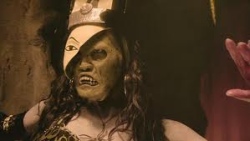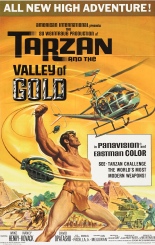
 The poster for Tarzan and the Valley of Gold shows Tarzan taking out a helicopter with bolas made from hand grenades. Since this actually happens in the movie, it is a perfectly acceptable thing to put on a poster. It is not, however, the most awesome thing to happen in it. That would be in the first 10 minutes, when Tarzan kills a henchman with an 8-foot bottle of Coke.
The poster for Tarzan and the Valley of Gold shows Tarzan taking out a helicopter with bolas made from hand grenades. Since this actually happens in the movie, it is a perfectly acceptable thing to put on a poster. It is not, however, the most awesome thing to happen in it. That would be in the first 10 minutes, when Tarzan kills a henchman with an 8-foot bottle of Coke.
In the ’60s, the franchise ran out of ways to have white people plunder the jungle so Tarzan could stop them. Actually, they ran out of new ways to tell that story in the ’40s; it just took them another 20 years to do something about it. And it took Sean Connery to show them how.
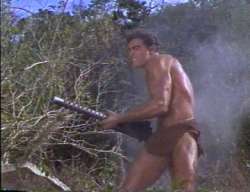 The popularity of the James Bond movies created countless rip-offs and spoofs, but none more awesome than the 007-influenced Tarzan films, especially the ones starring former pro linebacker Mike Henry, in which a dapper, literate Tarzan visited the jungles of the world, making friends and fighting crime. Valley of Gold was the first of such films and opens with him arriving in Mexico, suited up, and met at the airport by villainous goons à la Dr. No.
The popularity of the James Bond movies created countless rip-offs and spoofs, but none more awesome than the 007-influenced Tarzan films, especially the ones starring former pro linebacker Mike Henry, in which a dapper, literate Tarzan visited the jungles of the world, making friends and fighting crime. Valley of Gold was the first of such films and opens with him arriving in Mexico, suited up, and met at the airport by villainous goons à la Dr. No.
It’s a short trip from there to giant beverages, grenade bolas, forming a tracking team of wild animals, discovering a lost civilization, and swinging through the trees to a tune that would make Austin Powers jealous. —Michael May

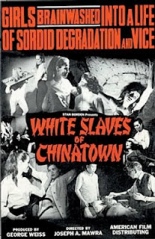
 In the first of a five-film franchise known as the
In the first of a five-film franchise known as the 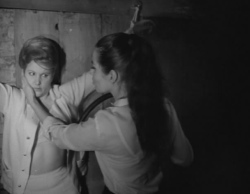

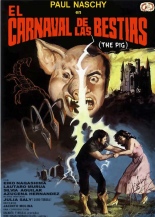
 In this odd but enjoyable thriller (aka The Beasts’ Carnival) from Spanish hyphenate Paul Naschy, he plays Bruno Rivera, who’s hired by an organization affiliated with his Asian girlfriend (Eiko Nagashima) to snag some diamonds. Syke! He double-crosses them and takes the jewels for himself, but the ruse is not without bloodshed.
In this odd but enjoyable thriller (aka The Beasts’ Carnival) from Spanish hyphenate Paul Naschy, he plays Bruno Rivera, who’s hired by an organization affiliated with his Asian girlfriend (Eiko Nagashima) to snag some diamonds. Syke! He double-crosses them and takes the jewels for himself, but the ruse is not without bloodshed. 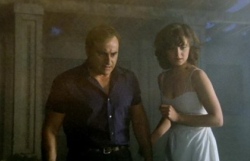
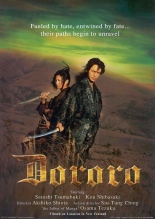
 Should you happen to find a basket floating in the river containing a baby with no eyes, arms or legs, don’t freak out — it’s probably just Hyakkimaru! As created by manga master Osamu Tezuka (
Should you happen to find a basket floating in the river containing a baby with no eyes, arms or legs, don’t freak out — it’s probably just Hyakkimaru! As created by manga master Osamu Tezuka (